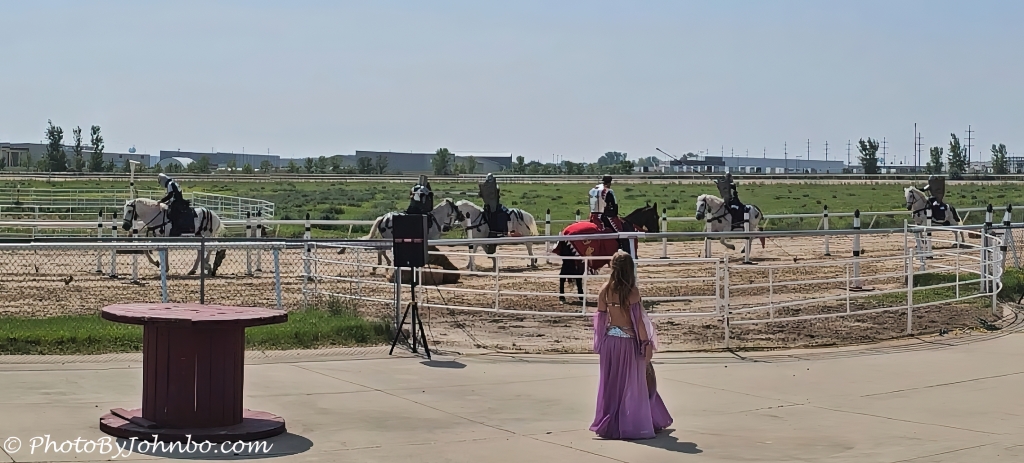
Fargo, North Dakota.
The 2nd annual North Dakota Renaissance Faire presented an opportunity to try out a new module in Luminar Neo. See the details in the About this photo section below. Lynn and I have only been to a couple of Renaissance Fairs, both of them in the Phoenix area. Though there is a major fair in the Minneapolis metro, we’ve never attended. Last year, King Caesar Productions brought their fair to Fargo. We were happy to attend and we enjoyed going with our daughter and grandson.
This year we were happy to see them back again, but as it turns out with a bit of controversy. I will tell that story in a future post featuring more images from the fair. In the meantime, here’s a teaser image of a match at the jousting tournament. Notice that there seem to be four jousters against one. The explanation? It’s a feature, not a bug.
About the photo: Recently Skylum Software added a new module to Luminar Neo that creates panoramic images from multiple images stitched together. While it’s nice to have the option in Neo, I’ve been using that feature in Adobe Lightroom Classic for a very long time. Here’s why I chose to use Neo to create this panorama.
Ukrainian-based Skylum software often thinks “outside the box” and they created an option for their panoramic module that steps out of the box and further. Instead of selecting several images to stitch together, you can choose a video instead. From that video, you can select the start and end points of the video that you’d like to include, and the module will stitch those frames together to create a single panoramic image. To try it out, I captured a couple of videos from the jousting match with my Samsung S23U cell phone.
Skylum’s developers didn’t just stop there with the module. They added a feature called Custom Object Composition. With this tool, you can scan through the video and select several frames to highlight a moving object. I chose to highlight the defeated jouster, the one moving right to left. I selected four frames and drew a box around the jouster as he progressed across the video. When Luminar Neo processed the frames into a panorama, it placed the highlighted subject into the image at the points I selected.
The screenshot above shows how easy the module is to use. The video started before the jousters were ready to go so I just moved the video start point to the right on the timeline. The leftmost blue square with the white dot indicates that I drew a frame around the jouster at the start of the video. The next blue square indicates I added a frame in the video. The third blue square is the current box where the two jousters meet in the center. I went on to add one more frame after the jouster lost the match and dropped his weapon. From there, I hit the Continue box and the program finished creating the panorama.
I have seen better examples of how to use this tool, but I was impressed at how well the program operates in this mode. When the panorama was created, I cropped the top and bottom to remove extraneous negative space and ran the Supersharp module and the Upscale module to add additional sharpness and detail to the image. You can click on the image above to view it in 2K HD via my Flickr site. I seldom take videos, but with this feature in mind, I will probably add them as I come across appropriate subjects.
I encourage fellow bloggers to create their own Cellpic Sunday posts. I never have a specific topic for this feature, and the only rules are that the photo must be captured with a cell phone, iPad, or another mobile device… If you have an image from a drone or even a dashcam, that’s acceptable as well. The second rule is to link your challenge response to this post or leave a comment here with a link to your post in the comment. Oh, and, you don’t have to post it on a Sunday.
John Steiner


enjoy your Sunday 🙂
[…] In response to Cellpic Sunday – The Jousting Match. […]
[…] Weekend Sky Cellpic Sunday […]
[…] For Cee Neuner’s FOTD – September 24 – Zinneas and Johnbo’s Cellpic Sunday – The Jousting Match […]
Nice to know about the luminar Neo addition.
Thank you.
Lots going on in the photo processing world. It’s hard to keep up.
I’ve attended two of these festivals years ago back home in Michigan, they were fun! Jousting is a very dangerous sport…
Indeed it is. I am amazed at the force that hits the riders.
And, how many have died.
What an amazing spectacle to see 😃
Indeed, fun day at the Faire!
[…] Steiner, the blogger behind Journeys With Johnbo, has this prompt he calls Cellpic Sunday in which he asks us to post a photo that was taken with a cellphone, tablet, or another mobile […]
[…] your friendly neighborhood park squirrel munching on something tasty. John at Journeys with Johnbo hosts Cellpic […]
Here’s mine for this week.
Thanks for participating!
[…] Hi all 😃 This is my latest post for John’s Cellpic Sunday. […]
[…] John’s Cellpic Sunday 24 September […]
Looks like you had fun at the faire and with technology John 🙂
Indeed, Brian! Our grandson came with and it was a great family outing.
[…] Cellpic Sunday – The Jousting Match […]
[…] Photobyjohnbo-Cell-Pic-Sunday23-0924 […]
[…] John’s Cell Pic Sunday […]
Hi John, what a great idea. I created a book trailer this weekend. I can see how the photo stretches. I think I could do that on Microsoft Clipchamp. I should try that. I have a pano feature on my cellphone, too.
❤️